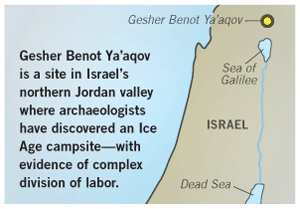 Setting
Up Camp After Babel by John UpChurch
Setting
Up Camp After Babel by John UpChurchSubscriber Exclusives
Did the various families who left Babel leave any trace of their journeys? New discoveries in Israel hint at surprising complexity among the first wayfarers to pass through that land.
Except for one minor detail, this campsite might seem unremarkable. Camping near a lake, a group of people built a fire to cook fish and other fresh food, while others divided several other chores among themselves. What’s unique? This amazingly preserved campsite was left by people who first spread out from Babel.
The site, Gesher Benot Ya’aqov in Israel’s northern Jordan valley, adjoins the shore of a now-vanished lake from the post-Flood Ice Age. Recent digs have uncovered many remnants of an ancient camp that closely resembles what we might expect to find at a modern Survivor camp.
The complex division of labor surprises secular archaeologists, who date the site to around 800,000 years ago in the so-called Lower Paleolithic. This date also pushes back the use of controlled fire by nearly 400,000 years, by their reckoning—into the time of so-called “early” humans (Homo erectus), who were not supposed to be as advanced as “modern” humans (Homo sapiens sapiens).1

Because these remains are found in higher, post-Flood layers, creationists believe they were left by some of Noah’s descendants who had dispersed from Babel. The remains of tools and hearths help us reconstruct many details about the people who were on the move. Though the tools are simple, their owners’ intelligence is obviously not.
At one level, archaeologists uncovered different areas of human activity.2 One was a hearth with remnants of burnt wood, including wild grape, olive, ash, and oak. Nearby, they found discarded fish parts, mostly from an extinct carp, and the remains of freshwater turtles and crabs, as well as many seeds, nuts, and fruits.
Near the hearth researchers also found evidence that the campers were making flint, basalt, and limestone tools, such as hand axes, scrapers, and hammers. Many rock anvils showed pits that likely occurred from cracking nuts open.
So this group not only worked together in food preparation and tool-making, but they also caught local fish, hunted and slaughtered big game (such as elephant and fallow deer), gathered all sorts of fruits and nuts, and roasted this food over a fire. They also quarried different kinds of rock for tools.
Since no human fossils have been uncovered at the site, archaeologists can only assume what the inhabitants looked like, based on the other human fossils found in Ice Age (Pleistocene) sites, such as Homo erectus or so-called “archaic Homo sapiens.” But even they realize that this is based on big assumptions.
Bible believers, on the other hand, would attribute this site—and its amazing preservation—to a much more recent group of travelers, who found themselves thrust into an unknown world after the Flood.
Footnotes
- Naama Goren-Inbar et al., “Evidence of Hominin Control of Fire at Gesher Benot Ya-aqov, Israel,” Science 304 (April 30, 2004): 725–727. The dating is based on radiometric dating of basalt rocks in the area.
- Nira Alperson-Afil et al., “Spatial Organization of Hominin Activities at Gesher Benot Ya-aqov, Israel,” Science 326 (December 18, 2009): 1677–1680. Back